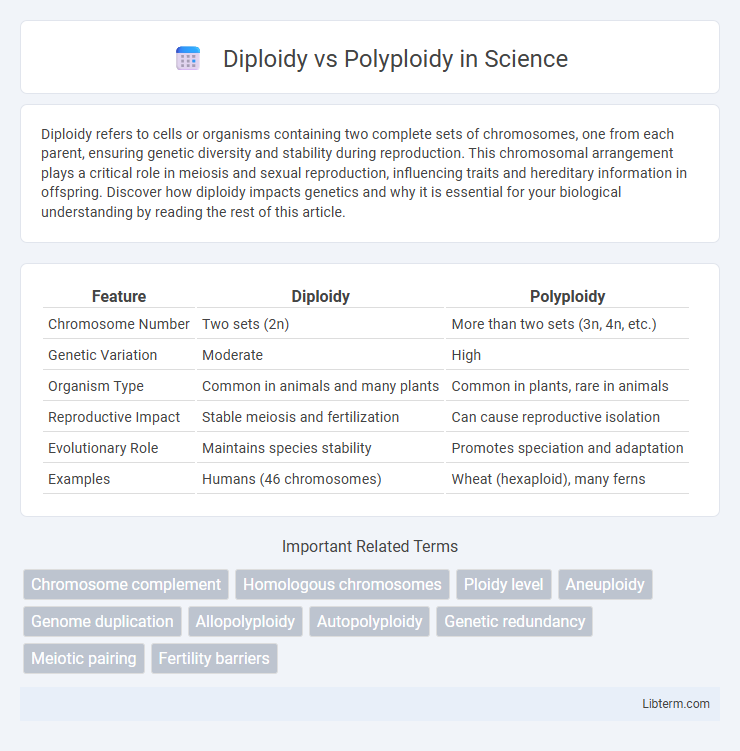Diploidy refers to cells or organisms containing two complete sets of chromosomes, one from each parent, ensuring genetic diversity and stability during reproduction. This chromosomal arrangement plays a critical role in meiosis and sexual reproduction, influencing traits and hereditary information in offspring. Discover how diploidy impacts genetics and why it is essential for your biological understanding by reading the rest of this article.
Table of Comparison
| Feature | Diploidy | Polyploidy |
|---|---|---|
| Chromosome Number | Two sets (2n) | More than two sets (3n, 4n, etc.) |
| Genetic Variation | Moderate | High |
| Organism Type | Common in animals and many plants | Common in plants, rare in animals |
| Reproductive Impact | Stable meiosis and fertilization | Can cause reproductive isolation |
| Evolutionary Role | Maintains species stability | Promotes speciation and adaptation |
| Examples | Humans (46 chromosomes) | Wheat (hexaploid), many ferns |
Introduction to Ploidy: Diploidy and Polyploidy
Diploidy refers to cells or organisms with two complete sets of chromosomes, one inherited from each parent, which is typical in most animals and many plants. Polyploidy involves having more than two sets of chromosomes, resulting in triploid, tetraploid, or higher multiples, commonly found in plants and some animals, contributing to genetic diversity and evolution. Understanding diploidy and polyploidy is essential for studying genetic variation, speciation, and plant breeding strategies.
Defining Diploidy: Structure and Function
Diploidy refers to the condition in which a cell or organism possesses two complete sets of chromosomes, one inherited from each parent, resulting in homologous chromosome pairs within the nucleus. This chromosomal architecture supports genetic stability, proper segregation during meiosis, and maintains allele diversity critical for sexual reproduction. In humans and most animals, diploidy underpins normal growth, development, and physiological function by ensuring balanced gene expression and inheritance patterns.
Understanding Polyploidy: Types and Mechanisms
Polyploidy refers to the condition in which an organism has more than two complete sets of chromosomes, contrasting with diploidy where only two sets are present. The main types of polyploidy include autopolyploidy, resulting from chromosome duplication within a single species, and allopolyploidy, which arises from hybridization between different species followed by chromosome doubling. Mechanisms driving polyploidy involve errors in meiosis or mitosis, leading to unreduced gametes and contributing to genetic variation and speciation in plants and some animal groups.
Evolutionary Origins of Diploidy and Polyploidy
Diploidy originated as a stable genomic state in early eukaryotes to maintain genetic diversity and facilitate homologous chromosome pairing during meiosis, enhancing adaptive evolution. Polyploidy, arising through whole-genome duplication events, has played a significant role in plant evolution and speciation by increasing genetic material, promoting ecological adaptation and reproductive isolation. Both diploidy and polyploidy contributed distinct pathways for genomic complexity and evolutionary innovation across diverse taxa.
Genetic Consequences: Variation and Mutation Rates
Diploidy, characterized by two sets of chromosomes, maintains genetic stability with lower mutation rates due to efficient DNA repair mechanisms and balanced allele expression. Polyploidy, involving multiple chromosome sets, increases genetic variation by providing duplicated gene copies that can accumulate mutations without detrimental effects, enhancing evolutionary adaptability. This genomic redundancy in polyploids leads to higher mutation rates and novel gene functions, fostering greater phenotypic diversity and speciation potential.
Diploidy vs Polyploidy: Advantages and Disadvantages
Diploidy, characterized by two sets of chromosomes, offers genetic stability and easier meiotic pairing but limits genetic diversity compared to polyploidy. Polyploidy, with multiple chromosome sets, enhances genetic variation and can lead to increased size and adaptability but often causes meiotic complications and reduced fertility. The choice between diploidy and polyploidy influences evolutionary potential, species adaptability, and breeding strategies.
Role in Plant and Animal Kingdoms
Diploidy, characterized by two sets of chromosomes, is predominant in most animals and many plants, ensuring genetic stability and facilitating sexual reproduction. Polyploidy, involving multiple chromosome sets, is especially significant in plants, contributing to speciation, increased genetic diversity, and adaptation to environmental changes. In animals, polyploidy is rarer but can influence evolutionary processes and developmental biology in certain species.
Polyploidy in Agriculture and Crop Improvement
Polyploidy, the condition of possessing more than two complete sets of chromosomes, plays a crucial role in agriculture by enhancing crop traits such as yield, size, and stress resistance. Many staple crops like wheat, cotton, and potatoes exhibit polyploidy, which contributes to their adaptability and improved genetic diversity for breeding programs. Polyploid breeding techniques are extensively utilized to develop hybrids with superior qualities, boosting food security and crop resilience against environmental challenges.
Impact on Speciation and Biodiversity
Diploidy, involving two sets of chromosomes, typically maintains genetic stability and limits rapid speciation, while polyploidy, characterized by multiple chromosome sets, often accelerates speciation by creating reproductive barriers and novel genetic combinations. Polyploid species contribute significantly to biodiversity, especially in plants, by enabling adaptation to diverse environments and ecological niches. The occurrence of polyploidy is a major evolutionary mechanism promoting genetic diversity and species richness within ecosystems.
Future Perspectives in Ploidy Research
Future perspectives in ploidy research emphasize advanced genomic editing tools to manipulate diploid and polyploid organisms for improved crop yields and stress resistance. Integrating high-throughput sequencing with bioinformatics enables deeper understanding of gene dosage effects and genome stability in polyploid species. Synthetic biology approaches aim to create novel ploidy variants, unlocking new traits and accelerating plant breeding programs for sustainable agriculture.
Diploidy Infographic

 libterm.com
libterm.com